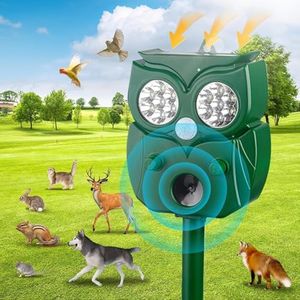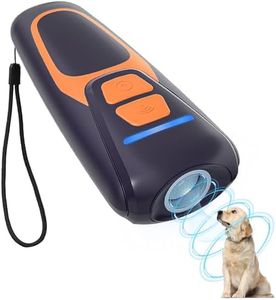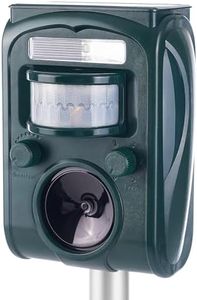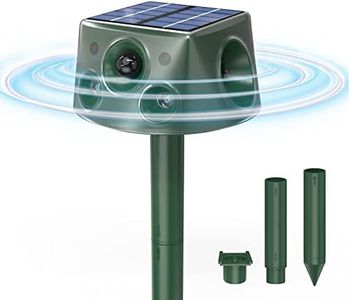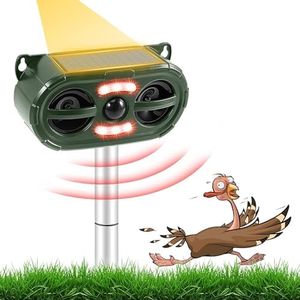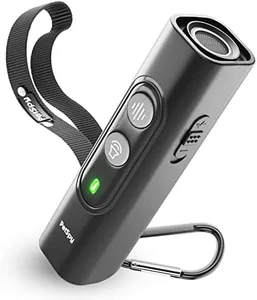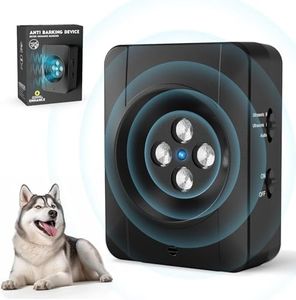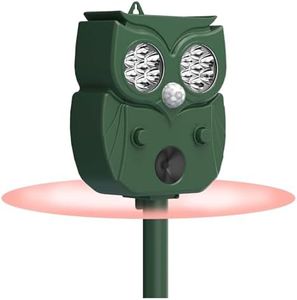We Use CookiesWe use cookies to enhance the security, performance,
functionality and for analytical and promotional activities. By continuing to browse this site you
are agreeing to our privacy policy
10 Best Ultrasonic Dog Repellers
From leading brands and best sellers available on the web.Buying Guide for the Best Ultrasonic Dog Repellers
Choosing an ultrasonic dog repeller can help you deter unwanted dog behavior or keep stray dogs away in a safe, humane way. Since these devices use sound at frequencies higher than what humans can hear, they're a popular choice for those looking to avoid physical or chemical deterrents. When shopping for an ultrasonic dog repeller, it’s important to look at key specifications to make sure the device fits your situation, whether it’s for use on walks, in the yard, or around your property. Understanding these specs will help you get the safest and most effective device for your needs.Frequency RangeThe frequency range refers to the pitch of the sound waves the repeller emits, usually measured in kilohertz (kHz). This is important because it determines whether dogs can actually hear the device and how effective it will be at getting their attention or deterring them. Most dog repellers work around 20-25 kHz. Devices with a broader or adjustable frequency range can target different dog sensitivities, which can be useful if you’re not sure what works best on the dogs you’re dealing with. If you need to deter a variety of dogs, or want to ensure the sound is above the range of human hearing, look for a higher and possibly adjustable frequency.
Effective Range (Distance)The effective range tells you how far the device can work from where you're standing, usually given in feet or meters. This is key for knowing how close a dog needs to be for the device to work. Small-range models (up to 15 feet) are good for personal protection or small areas, while medium-range (15-30 feet) suits walking or jogging in public spaces. Long-range models (over 30 feet) are best for open areas or protecting your yard. Choose the range that matches how and where you plan to use the device most often.
Power SourceUltrasonic dog repellers are powered either by batteries, rechargeable batteries, or plugged into an outlet. Battery-powered devices are usually portable, making them ideal for walks or outdoor activities, but require regular battery changes. Rechargeable ones are convenient for frequent use and eco-friendlier, though you need to remember to keep them charged. Plug-in units are stationary and suit home or yard use but can’t be taken on walks. Think about how often and where you’ll use the device to pick the best power source for you.
Portability and SizeSize and portability matter depending on if you need to carry the device with you or just leave it in a fixed place. Handheld, lightweight models are easy to slip into a pocket or bag for quick, on-the-go use. Larger, heavier devices often have more power but are meant to be set up at a fixed spot like your garden or entryway. If you want something for walks, look for compact and lightweight options; for home security, size is less of an issue.
Safety FeaturesSome repellers include safety features like automatic shutoff, adjustable frequency, and built-in flashlights or alarms. These are important to make sure the device doesn’t run nonstop (which could bother other animals or waste battery life) and gives flexibility in how you use it. Additional alarms or lights can also help attract attention or scare off dogs more effectively. Consider whether these extra features would make the device easier or safer for you to use.
Weather ResistanceMany people use these devices outdoors, so weather resistance (such as water or dust resistance) is an important consideration. This is usually indicated by an IP rating or mentioned in the product info. If you’ll use the device outside, especially in damp or dusty conditions, make sure it’s built to handle exposure or has an adequate protective rating. For indoor use, weatherproofing is less important.

